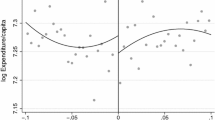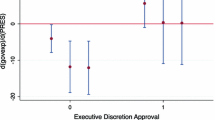Abstract
In accordance with the median voter theorem the median legislator is decisive in representative democracy. If the preferences of the median legislator differ from the preferences of the median voter in the polity, fiscal policy choices will predictably diverge from those favored by the median voter. This paper seeks to identify the median district (and therein the preferences driving the median legislator) in American State legislatures. Using economic characteristics of constituents, we find substantial differences between the median district and the statewide median. As the income of the median district rises above the median income of the polity, government expenditures increase. In addition, the degree to which income is skewed across legislative districts affects spending for redistribution programs. Finally, we find that direct democracy procedures, which allow the statewide median voter to check legislative decisions, limit the impact of differences between the district and polity medians.
Similar content being viewed by others
References
Alesina, A., & Roderick, D. (1994). Distributive politics and economic growth. Quarterly Journal of Economics, 109, 465–490.
Bergstrom, T. C., & Goodman, R. P. (1973). Private demands for public goods. American Economics Review, 63, 280–296.
Berry, William D., Ringquist, Evan J., & Fordig, Richard S. (1998). Measuring citizen and government ideology in the American States, 1960–93. American Journal of Political Science, 42(1), 327–348.
Black, D. (1958). The theory of committees and elections. Cambridge: Cambridge University Press.
Bowen, H. R. (1943). The interpretation of voting in the allocation of economic resources. Quarterly Journal of Economics, 58, 27–48.
Bradbury, J. C., & Crain, W. M. (2001). Bicameral legislatures and fiscal policy. Southern Economic Journal, 68, 646–659.
Bradbury, J. C., & Crain, W. M. (2001). Legislative organization and government spending: Cross-country evidence. Journal of Public Economics, 82, 309–325.
Bradbury, J. C., & Johnson, J. M. (2002). Do Supermajority rules limit or enhance tyranny of majority spending? Evidence from the US States, 1960–1997. Manuscript.
Chicoine, D. L., Walzer, N., & Deller, S. C. (1989). Representative vs. direct democracy and government spending in a median voter model. Public Finance, 44, 225–236.
Crain, W. M. (1999). Districts, diversity, and fiscal biases: Evidence from the American States. Journal of Law and Economics, 52, 675–698.
Crain, W. M. (2003). Volatile states: Institutions, policy, and the performance of American state economies, Ann Arbor: University of Michigan Press.
Crain, W. M., & James C. M. III (1990). Budget process and spending growth. William and Mary Law Review, 31(4), 1021–1046.
Downs, A. (1957). An economic theory of democracy. New York: Harper and Row.
Feld, S. L., Grofman, B., & Miller, N. (1988). Centripetal forces in spatial voting: On the size of the yolk. Public Choice, 59, 37–50.
Fisher, Ronald C. (1996). State and local public finance. Boston: Irwin.
Gilligan, T. W., & Matsusaka, J. G. (1993). Seats and spending: Legislative structure and median voter outcomes. University of Southern California. Unpublished manuscript.
Gilligan, T. W., & Matsusaka, J. G. (1997). Structural constraints on partisan bias under the efficient gerrymander. Public Choice, 100, 65–84.
Holcombe, R. G. (1980). An empirical test of the median voter model. Economic Inquiry, 18, 260–274.
Holcombe, R. G. (1978). Public choice and public spending, National Tax Journal, 31, 373–383.
Holcombe, R. G., & Caudill, S. B. (1985). Tax shares and government spending in the median voter model. Public Choice, 46, 197–206.
Hotelling, H. (1929). Stability in competition. Economic Journal. 39, 41–57.
Husted, T. A., & Kenny, L. W. (1997). The effect of the expansion of the voting franchise on the size of government. Journal of Political Economy, 105, 54–82.
Inman, R. P. (1978). Testing political economy's ‘As if’ proposition: Is the median voter really decisive? Public Choice, 33, 45–65.
Inman, R. P., & Henning B. (1996). Balanced-budget rules and public deficits: Evidence from the US States. Carnegie-Rochester Conference Series on Public Policy, 45, 13–76.
Kenny, L. W. (1978). The collective allocation of commodities in a democratic society: A generalization. Public Choice, 33, 117–120.
Knight, B. G. (2001). Supermajority voting requirements for tax increases: Evidence from the States. Journal of Public Economics, 76, 41–67.
Krussell, P., & Rios-Rull, J-V (1999). “On the size of US government: Political economy in the neoclassical growth model. American Economic Review, 89, 1156–1181.
Lilley, DeFranco, and Diefenderfer (1995). Almanac of State Legislatures, Diskette. Washington, DC: Congressional Quarterly, Inc.
Lott, J. R., & Kenny, L. W. (1999). Did woman's suffrage change the size and scope of government? Journal of Political Economy, 107, 163–198.
Matsusaka, J. G. (1992). Economics of direct legislation. Quarterly Journal of Economics, 107, 541–571.
Matsusaka, J. G. (1995). Fiscal effects of the voter initiative: Evidence from the last 30 years. Journal of Political Economy, 103, 587–623.
McKelvey, R. D. (1986). Covering, dominance, and institution-free properties of social choice. American Journal of Political Science, 30, 283–314.
Meltzer, A., & Richard, S. (1983). Tests of a rational theory of the size of government. Public Choice, 41, 403–418.
Meltzer, A., & Richard, S. (1981). A rational theory of the size of government. Journal of Political Economy, 89, 914–927.
Miller, N. (1980). A new ‘solution set’ for tournaments and majority voting. American Journal of Political Science, 24, 68–96.
Mueller, D. (2003). Public Choice III. Cambridge University Press.
Munley, V. G. (1984). Has the median voter found a ballot box that he can control? Economic Inquiry, 22, 323–336.
Niskanen, W. A. (1971). Bureaucracy and representative government. Chicago: Aldine & Atherton.
Niskanen, W. A. (1975). Bureaucrats and politicians. Journal of Law and Economics, 18, 617–643.
Peltzman, S. (1992). Voters as fiscal conservatives. Quarterly Journal of Economics, CVII (2). 327–361.
Perotti, R. (1993). Political equilibrium, income distribution, and growth. Review of Economic Studies, 60, 755–776.
Persson, T., & Tabellini, G. (1994). Is inequality harmful for growth? American Economic Review, 84, 600–621.
Pommerehne, W. W. (1978). Institutional approaches to public expenditure: Empirical evidence from swiss municipalities. Journal of Public Economics, 9, 255–280.
Pommerehne, W. W., & Frey, B. S. (1978). Bureaucratic behavior in democracy: A case study. Public Finance/Finances Publiques, 33, 98–112.
Pommerehne, W. W., & Schneider, F. (1978). Fiscal illusion, political institutions, and local public spending. Kyklos, 31, 381–408.
Poterba, J. M. (1997). Do Budget Rules Work? in Fiscal Policy: Lessons from Economic Research, Alan J. Auerbach (Ed.), Cambridge, MA: The MIT Press: 53–86. (Reprinted as NBER No. 2152.).
Poterba, J. M. (1996). “Budget institutions and fiscal policy in the US states.” American Economic Review, 86, 395–400.
Ram, Rati (1987). “Wagner's Hypothesis in time-series and cross-section perspectives.” Review of Economics and Statistics, 69, 194–204.
Romer, T., & Rosenthal, H. (1979a). “The elusive median voter.” Journal of Public Economics, 12, 143–170.
Romer, T., & Rosenthal, H. (1979b). “Bureaucrats versus voters: On the political economy of resource allocation by direct democracy.” Quarterly Journal of Economics, 93, 563–587.
Romer, T., & Rosenthal, H. (1982). “Median voters or budget maximizers: Evidence from school expenditure referenda.” Economic Inquiry, 20, 556–578.
Santerre, Rexford E. (1986). “Representative versus direct democracy: A Tieboat test of relative performance.” Public Choice, 48, 55–63.
Author information
Authors and Affiliations
Corresponding author
Rights and permissions
About this article
Cite this article
Bradbury, J.C., Crain, W.M. Legislative district configurations and fiscal policy in American States. Public Choice 125, 385–407 (2005). https://doi.org/10.1007/s11127-005-3058-7
Accepted:
Issue Date:
DOI: https://doi.org/10.1007/s11127-005-3058-7




